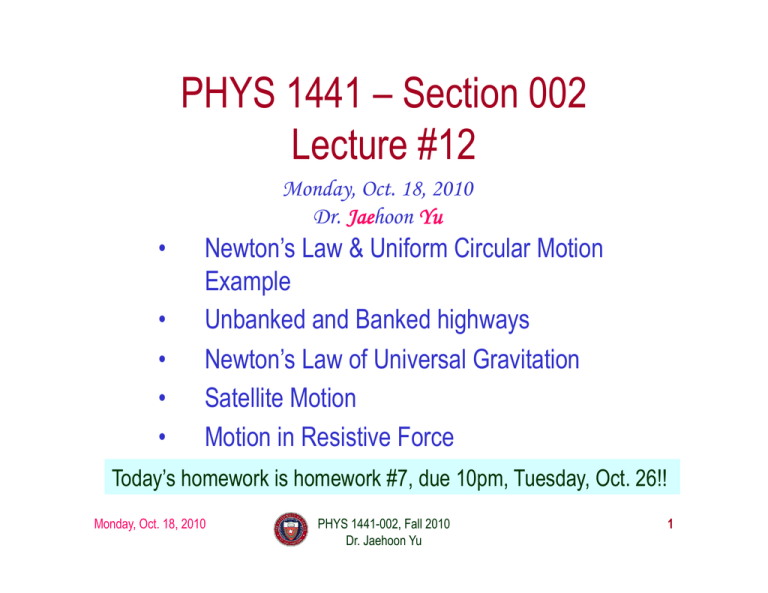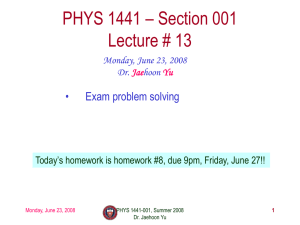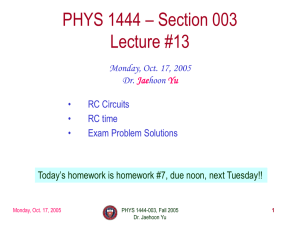PHYS 1441 – Section 002 Lecture #12
advertisement

PHYS 1441 – Section 002 Lecture #12 Monday, Oct. 18, 2010 Dr. Jaehoon Yu • • • • • Newton’s Law & Uniform Circular Motion Example Unbanked and Banked highways Newton’s Law of Universal Gravitation Satellite Motion Motion in Resistive Force Today’s homework is homework #7, due 10pm, Tuesday, Oct. 26!! Monday, Oct. 18, 2010 PHYS 1441-002, Fall 2010 Dr. Jaehoon Yu 1 Announcements • 2nd non-comprehensive term exam – Date: Wednesday, Nov. 3 – Time: 1 – 2:20pm in class – Covers: CH3.5 – what we finish Monday, Nov. 1 • Physics faculty research expo this Wednesday Monday, Oct. 18, 2010 PHYS 1441-002, Fall 2010 Dr. Jaehoon Yu 2 Special Project • Using the fact that g=9.80m/s2 on the Earth’s surface, find the average density of the Earth. – Use the following information only • The gravitational constant G = 6.67 × 10−11 N ⋅ m2 kg 2 • The radius of the Earth RE = 6.37 × 103 km • 20 point extra credit • Due: Wednesday, Oct. 27 • You must show your OWN, detailed work to obtain any credit!! Monday, Oct. 18, 2010 PHYS 1441-002, Fall 2010 Dr. Jaehoon Yu 4 Newton’s Second Law & Uniform Circular Motion The centripetal * acceleration is always perpendicular to the velocity vector, v, and points to the center of the axis (radial direction) in a uniform circular motion. Are there forces in this motion? If so, what do they do? The force that causes the centripetal acceleration acts toward the center of the circular path and causes the change in the direction of the velocity vector. This force is called the centripetal force. What do you think will happen to the ball if the string that holds the ball breaks? The external force no longer exist. Therefore, based on Newton’s 1st law, the ball will continue its motion without changing its velocity and will fly away following the tangential direction to the circle. Monday, Oct. 18, 2010 *MirriamPHYS Webster: Proceeding or acting in a direction toward a center or axis 1441-002, Fall 2010 Dr. Jaehoon Yu 5 Example of Uniform Circular Motion A ball of mass 0.500kg is attached to the end of a 1.50m long cord. The ball is moving in a horizontal circle. If the string can withstand maximum tension of 50.0 N, what is the maximum speed the ball can attain before the cord breaks? Centripetal acceleration: When does the string break? when the required centripetal force is greater than the sustainable tension. v2 m = T r Calculate the tension of the cord when speed of the ball is 5.00m/s. Monday, Oct. 18, 2010 50.0 × 1.5 Tr = 12.2 m / s = 0.500 m ( 2 m ( 5.00 v = 0.500 × r 1.5 PHYS 1441-002, Fall 2010 Dr. Jaehoon Yu ) 2 ) ( ) = 8.33 N 6 Unbanked Curve and Centripetal Force On an unbanked curve, the static frictional force provides the centripetal force. Monday, Oct. 18, 2010 PHYS 1441-002, Fall 2010 Dr. Jaehoon Yu 7 Banked Curves On a frictionless banked curve, the centripetal force is the horizontal component of the normal force. The vertical component of the normal force balances the car’s weight. Monday, Oct. 18, 2010 PHYS 1441-002, Fall 2010 Dr. Jaehoon Yu 8 Ex. 5 – 7 Bank Angle (a) For a car traveling with speed v around a curve of radius r, determine the formula for the angle at which the road should be banked so that no friction is required to keep the car from skidding. 2 mv x comp. ∑ Fx = FN sin θ = mar = r y y comp. x (b) What is this angle for an expressway off-ramp curve of radius 50m at a design speed of 50km/h? tan θ = Monday, Oct. 18, 2010 (14 )2 50 × 9.8 = 0.4 PHYS 1441-002, Fall 2010 Dr. Jaehoon Yu 9 Ex. The Daytona 500 The Daytona 500 is the major event of the NASCAR season. It is held at the Daytona International Speedway in Daytona, Florida. The turns in this oval track have a maximum radius (at the top) of r=316m and are banked steeply, with θ=31o. Suppose these maximum radius turns were frictionless. At what speed would the cars have to travel around them? 2 v x comp. FN sin θ = mac = m r y comp. FN cosθ − mg = 0 y x mv 2 v2 tan θ = = mgr gr v 2 = gr tan θ v= gr tan θ = ( ) 9.8 ⋅ 316 tan 31 = 43m s = 96 mi hr Monday, Oct. 18, 2010 PHYS 1441-002, Fall 2010 Dr. Jaehoon Yu 10 Newton’s Law of Universal Gravitation People have been very curious about the stars in the sky, making observations for a long time. The data people collected, however, have not been explained until Newton has discovered the law of gravitation. Every particle in the Universe attracts every other particle with a force that is directly proportional to the product of their masses and inversely proportional to the square of the distance between them. How would you write this law mathematically? m1 m2 r122 G With G G is the universal gravitational constant, and its value is m1m2 r122 Unit? This constant is not given by the theory but must be measured by experiments. This form of forces is known as the inverse-square law, because the magnitude of the force is inversely proportional to the square of the distances between the objects. Monday, Oct. 18, 2010 PHYS 1441-002, Fall 2010 Dr. Jaehoon Yu 11 Why does the Moon orbit the Earth? Monday, Oct. 18, 2010 PHYS 1441-002, Fall 2010 Dr. Jaehoon Yu 12 Gravitational Force and Weight Gravitational Force, Fg The attractive force exerted on an object by the Earth F G = ma = mg Weight of an object with mass M is What is the SI unit of weight? F G = M g = Mg N Since weight depends on the magnitude of gravitational acceleration, g, it varies depending on geographical location. By measuring the forces one can determine masses. This is why you can measure mass using the spring scale. Monday, Oct. 18, 2010 PHYS 1441-002, Fall 2010 Dr. Jaehoon Yu 13 Gravitational Acceleration MEm G r On the surface of the Earth 2 G = 6.67 × 10−11 N ⋅ m 2 kg 2 M E = 5.98 × 1024 kg; RE = 6.38 × 106 m mg G ( = 6.67 × 10 g= G ME r2 Gravitational acceleration at distance r from the center of the earth! What is the SI unit of g? Monday, Oct. 18, 2010 ME RE2 (5.98 × 10 kg ) kg ) (6.38 × 10 m ) 24 −11 N ⋅m 2 2 6 = 9.80 m s 2 m/s2 PHYS 1441-002, Fall 2010 Dr. Jaehoon Yu 14 2 Satellite in Circular Orbits There is only one speed that a satellite can have if the satellite is to remain in an orbit with a fixed radius. What is the centripetal force? The gravitational force of the earth pulling the satellite! Fc = G mM E v = 2 Monday, Oct. 18, 2010 r 2 2 v =m r GM E r GM E v= PHYS 1441-002, Fall 2010 Dr. Jaehoon r Yu 15 Period of a Satellite in an Orbit GM E 2π r v= = r T Speed of a satellite GM E ⎛ 2π r ⎞ =⎜ ⎟ r ⎝ T ⎠ Period of a satellite 2 T2 Square either side and solve for T2 T= 2π r 2π ) ( = 2 r 3 GM E 32 GM E Kepler’s 3rd Law This is applicable to any satellite or even for planets and moons. Monday, Oct. 18, 2010 PHYS 1441-002, Fall 2010 Dr. Jaehoon Yu 16 Geo-synchronous Satellites Global Positioning System (GPS) Satellite TV What period should these satellites have? The same as the earth!! 24 hours Monday, Oct. 18, 2010 PHYS 1441-002, Fall 2010 Dr. Jaehoon Yu 17 Ex. Apparent Weightlessness and Free Fall 0 0 In each case, what is the weight recorded by the scale? Monday, Oct. 18, 2010 PHYS 1441-002, Fall 2010 Dr. Jaehoon Yu 18 Ex. Artificial Gravity At what speed must the surface of the space station move so that the astronaut experiences a push on his feet equal to his weight on earth? The radius is 1700 m. 2 v Fc = m = mg r v = rg = (1700 m )(9.80 m s ) 2 = 130 m s Monday, Oct. 18, 2010 PHYS 1441-002, Fall 2010 Dr. Jaehoon Yu 19 Motion in Resistive Forces Medium can exert resistive forces on an object moving through it due to viscosity or other types frictional properties of the medium. Some examples? Air resistance, viscous force of liquid, etc These forces are exerted on moving objects in opposite direction of the movement. These forces are proportional to such factors as speed. They almost always increase with increasing speed. Two different cases of proportionality: 1. Forces linearly proportional to speed: Slowly moving or very small objects 2. Forces proportional to square of speed: Large objects w/ reasonable speed Monday, Oct. 18, 2010 PHYS 1441-002, Fall 2010 Dr. Jaehoon Yu 20


